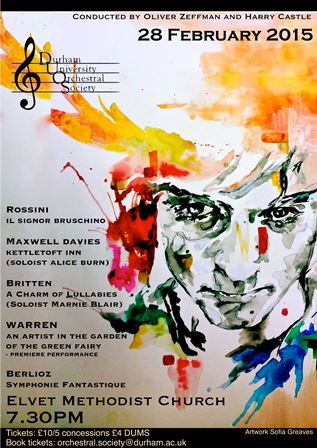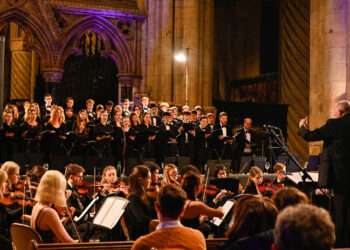 Fantastic dreams, restless dances, storms and disturbed sleep swirled together in Durham University Orchestral Society’s Epiphany term concert in a programme of vividly evocative music that used the entire rich palette available to the orchestral composer – plus a few extras.
Fantastic dreams, restless dances, storms and disturbed sleep swirled together in Durham University Orchestral Society’s Epiphany term concert in a programme of vividly evocative music that used the entire rich palette available to the orchestral composer – plus a few extras.
Rossini’s overture Il Signor Bruschino provided a light introduction, a sparkly aperitif before the weightier, more interesting things that followed. The DUOS Chamber Orchestra, conducted by Oliver Zeffman bounced cheerily through it, and had plenty of fun with Rossini’s unorthodox percussion – violin bows tapped on the music stands.
One of Peter Maxwell Davies’s best known pieces is his An Orkney Wedding, with Sunrise which ends gloriously with the arrival of a piper, but this isn’t the only piece he’s written for pipes. Kettletoft Inn, for Northumbrian pipes and a quintet of strings plus cor anglais was written in 2006 for Kathryn Tickell, and was being played for only the second time this evening but it deserves to be more widely heard, and hopefully the resurgence of interest in Northumbrian folk music that Tickell has started will mean that there will soon be more pipers around to play it. Soloist Alice Burn beautifully showcased the plaintive, lyrical qualities of the Northumbrian pipes, a much gentler instrument than its Scottish cousin. Kettletoft Inn swings between expansive evocations of the vast moorland skies and relaxed, impromptu dances. Maxwell Davies integrates the pipes completely into the ensemble, they’re not just external colour like the piper in the Orkney wedding – the cor anglais, played with dexterity by Lucy Newton becomes almost an extra chanter, and the harmonies in the string writing mesh with the overtones of the pipes. Violinists Chris Hirschmann and Rebecca Howell captured the necessary fiddle-style for the off-key rustic dancing.
Britten’s Charm of Lullabies, in the orchestration by Colin Matthews, moved the programme on to ideas of sleep and dreams, but the tranquil title is deceptive. The rich tones of mezzo-soprano soloist Marnie Blair went expressively through all the emotions of a mother with a restless baby as tenderness and pride eventually give way to frustration and threats before eventually the mother recovers herself and both she and her baby settle. The orchestra were particularly effective in the fourth song, A charm as they stubbornly resisted the mother’s pleas and threats, and in the bite of the agonised wind chords in Sephestia’s Lullaby whilst the mother ponders the grief that her innocent child must one day suffer, but mostly they were far too loud, which was a pity. Marnie Blair’s passionate threats and cries of “Quiet” in A Charm perhaps had some effect though, because for the final movement, The Nurse’s Song the instruments did indeed settle, allowing her to blossom on her long low notes. The ending, so quiet and controlled, low in the contralto range, was magical.
The baby may have fallen asleep but what followed for the rest of the concert were troubled hallucinations. The first half ended with the winning entry in DUOS’s inaugural composition competition, and if this is an indication of the standards we can expect, then I hope that the competition continues. Matthew Warren’s title An Artist in the Garden of the Green Fairy sounded intriguing on the concert posters, but it made perfect sense when the programme notes revealed that the green fairy is of course the accursed absinthe, and when the music revealed that the piece is built around the central motif, the idée fixé, of Berlioz’s Symphonie Fantastique. An evocative quotation in the programme from Christina Rossetti’s “Goblin Market” just added to the ideas of a sinister fairy world that tempts the dreamer away from all that is wholesome. The piece begins with Berlioz’s theme in the strings, initially firm and confident but becoming troubled by little fluttery interjections from the winds and basses. These darting sprites become more insistent until they overwhelm the theme with a whirling, pulsating kaleidoscope, overlaid with a sinister swinging tune in the trumpets; it’s dark, dangerous and intoxicating. The theme struggles up for air from time to time, but is pulled back into the maelstrom until finally the madness subsides with tolling bells into a dying gasp of violas. This was accomplished orchestral writing, and a delight to listen to – congratulations to Matthew Warren and DUOS.
We had Warren’s inspiration in full in the second half – Berlioz’s Symphonie Fantastique. It’s a work where it’s tempting to skip straight to the good bits at the end, but the elegant lift that symphony orchestra conductor Harry Castle produced in the waltz passages reminded me how delightful the second movement, “A Ball” can be, and there were lots of nice bits of colour through the wanderings of the third. The trio of double basses were particularly impressive throughout the symphony, blooming with warmth and depth when needed and providing ballast for the really loud bits so that we felt the volume rather than being overwhelmed with sound. Among the many exposed and demanding woodwind solos, the bassoon soloist stood out for vivacious playing in the fourth movement, and the whole section for their interjections in the fifth. On this occasion though, the logistical arrangements required to fit a symphony orchestra into Elvet Methodist Church meant that the various sections of orchestra weren’t as rhythmically tight as they could have been.
It’s tempting for orchestras to run wild during the fun and games of the last two movements, but Harry Castle kept things tightly under control, saving the massive fortissimos for the most effective moments, and enabling us to hear all the detail of the inner parts instead of a wall of sound. The March to the Scaffold went at a firm and heavy tread, definitely a sinister march, and in the last movement I loved the way the tubas spat out the Dies Irae, in a mocking fusillade. I also like the idea of placing the bells behind the audience, setting them apart as a distinct, distant voice, the sound of the church cutting into the mayhem of the witches black dance.








